Long travel A-arms
| Herrmann Racing Long Travel A-arms w/ TCS Shocks |
 |
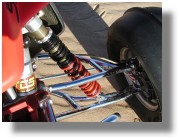 Brad Herrmann of Herrmann Racing makes very high quality ATV chassis components with high attention to detail. Located in a 16,000ft facility in Pennsburg, PA, Herrmann Racing is one branch of Green Lane Tool and Die Company established in 1957. It is family owned and has just about any type of metal working machines you can think of.
Brad Herrmann of Herrmann Racing makes very high quality ATV chassis components with high attention to detail. Located in a 16,000ft facility in Pennsburg, PA, Herrmann Racing is one branch of Green Lane Tool and Die Company established in 1957. It is family owned and has just about any type of metal working machines you can think of. 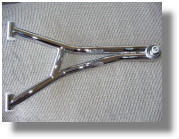 |
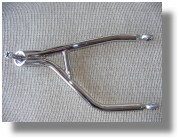 |
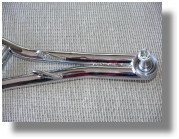 We were looking to upgrade our TRX250R suspension with a long travel front end. We wanted something that was high quality without paying top dollar. We settled on Herrmann’s +3/+1 long travel arms with TCS 19” shocks.
We were looking to upgrade our TRX250R suspension with a long travel front end. We wanted something that was high quality without paying top dollar. We settled on Herrmann’s +3/+1 long travel arms with TCS 19” shocks.
The arms are made of 4130 chromoly and tig welded together. They are gusseted in known weak area’s to ensure maximum strength. The long travel arms have king pin’s instead of ball joints along with heim joints on the upper arms where they bolt to the frame. This combination allows you to adjust camber and castor and gives maximum travel with no chance of a binding. Brad claims 12+ inches of travel with these arms depending on the shock set-up. A quick glance at these a-arms and its obvious Brad put a lot of time into designing them. The unique design simply looks like they can handle any abuse you can throw at them!
Normally the arms come completely assembled and powder coated the color of your choice. We opted to have them sent unassembled with no coating so we could have them chromed. After receiving the arms we sent them to Pacific Plating in San Diego, CA. Talking to Steve Ruiz of Pacific Plating, we learned that chroming metal is no simple task. The process first involves an acid bath followed by 4 stages of buffing: Dry wheel, Grease wheel, Seisel wheel, and a color buff. After the metal is prepped it is again given an acid bath, then nickel plating is applied and then dipped in Chrome. Pacific plating also polished the stainless steel tie rods to a chrome like appearance. We were very happy with how these a-arms turned out!
 The next step was putting them together and installing them onto the quad. The king pin set up is easy to install. The 1st step is to press the spherical bearings into each arm then insert the king pin through them. Moving the king pins around by hand we noticed them to have a lot more range of motion than a standard ball joint has. We installed the heim joints and lock nut into the upper arms with them bottomed out. Once the arms and tires were all installed we noticed that the tires had too much camber. (Top of the tires was tilted outward). We needed them to have negative camber. We couldn’t figure out how to get this without removing the lock nuts on the heim joints. We called Brad for support and he was very helpful. We found out the kingpins were installed incorrectly. The upper and lower pins are different length. After fixing that, we still had the same problem. We ended up sending them back to Brad for closer inspection. It turns out the arms fit in his jigs (jigs he has built hundreds of long travel arms with) perfectly. We are still unsure why they didn’t want to work on our frame. The only thing we can think of is either the frame or spindles are bent. To fix the problem we cut 1/8 inch off of each upper arm. They now sit perfectly!
The next step was putting them together and installing them onto the quad. The king pin set up is easy to install. The 1st step is to press the spherical bearings into each arm then insert the king pin through them. Moving the king pins around by hand we noticed them to have a lot more range of motion than a standard ball joint has. We installed the heim joints and lock nut into the upper arms with them bottomed out. Once the arms and tires were all installed we noticed that the tires had too much camber. (Top of the tires was tilted outward). We needed them to have negative camber. We couldn’t figure out how to get this without removing the lock nuts on the heim joints. We called Brad for support and he was very helpful. We found out the kingpins were installed incorrectly. The upper and lower pins are different length. After fixing that, we still had the same problem. We ended up sending them back to Brad for closer inspection. It turns out the arms fit in his jigs (jigs he has built hundreds of long travel arms with) perfectly. We are still unsure why they didn’t want to work on our frame. The only thing we can think of is either the frame or spindles are bent. To fix the problem we cut 1/8 inch off of each upper arm. They now sit perfectly!
Todd Davis at TCS sent us a set of his 19” Sag Control Series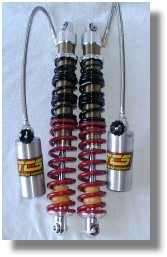 shocks. Todd has been in the shock business for over ten years. He was the “shock guy” for Race Tech for over eight years, where he developed a lot of skill and some different ideas. Wanting to put his ideas into practice, Todd struck a deal with CT Racing and in October 1998 he moved into a little shop in CT’s building. TCS did very well at CT, and eventually outgrew the space CT had available. Todd moved into bigger quarters in October 2000 and moved again to a larger facility last year in Lake Elsinore, CA.
shocks. Todd has been in the shock business for over ten years. He was the “shock guy” for Race Tech for over eight years, where he developed a lot of skill and some different ideas. Wanting to put his ideas into practice, Todd struck a deal with CT Racing and in October 1998 he moved into a little shop in CT’s building. TCS did very well at CT, and eventually outgrew the space CT had available. Todd moved into bigger quarters in October 2000 and moved again to a larger facility last year in Lake Elsinore, CA.
So just what are Sag Control System shocks, and what makes them so good? This is a good question, and difficult to answer without getting too technical and confusing. Quad shocks are all “coil over” shocks, with springs on the outside, which push on the shock body at one end and on the shock shaft at the other end. At the end of the shock shaft inside the shock body is a piston. As the piston is moved up and down in the shock body oil moves through valves (holes) in the piston. These valves control how fast the oil can move through the piston, and this controls the dampening. SCS shocks are different from most shocks both in the way the springs work and in the way the valves work. Stock shocks have one spring. Most stock and aftermarket shocks have adjustable preload settings to change how much the spring is compressed, which allows you to set ride height and change the spring rate at the same time. Aftermarket shocks with multiple springs have collars, which slide on the shock body where the springs meet and allow the transfer of force from one spring to another while keeping the spring ends together. When one spring is compressed the next spring takes over. Usually most of the shock travel compresses one long spring, and when it’s fully compressed a second shorter and stiffer spring takes over. As this spring compresses, the collar slides up the shock body. On triple rate shocks a third spring takes over when the second spring is fully compressed. On SCS shocks, which come in both double and triple spring versions, the top spring is very soft and just serves to stretch the shock out when the wheels come off the ground. When the weight is on the quad this spring compresses. The sag of this spring is controlled by an aluminum spacer tube around the shock body which stops the sliding collar and transfers the load to the one or two main springs when the suspension is compressed to the selected ride height: Sag Control System. Changing the “preload” settings on an SCS shock will change the ride height but will not affect the spring rate.
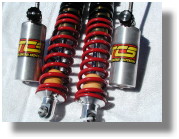 |
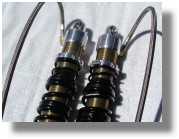 |
 The second way in which SCS shocks differ from most aftermarket shocks is in the valving. One time-honored way to control how fast the oil can move through the piston is to control the size of holes in the piston. Smaller holes produce greater dampening and larger holes produce less dampening. Compression dampening and rebound dampening can be controlled separately by putting one-way check valves on these holes, so one set of holes lets oil through the piston when the shock is being compressed, and another set of holes lets oil through when the shock is rebounding. Many high quality, premium shocks use this system. SCS shocks use another approach. Stacks of small metal shims are placed on both sides of the piston. When the compression or rebound force is light, these shims let oil through the piston for minimum dampening. However, when the compression or rebound force is hard, such as when landing a jump, the shims will bend and restrict the oil flow. The faster the oil tries to get through the shims the more the shims bend and restrict the oil flow. This makes the dampening proportional to the force on the shock. SCS front shocks provide additional adjustment by using reservoirs with compression dampening adjustment knobs similar to those found on rear shocks.
The second way in which SCS shocks differ from most aftermarket shocks is in the valving. One time-honored way to control how fast the oil can move through the piston is to control the size of holes in the piston. Smaller holes produce greater dampening and larger holes produce less dampening. Compression dampening and rebound dampening can be controlled separately by putting one-way check valves on these holes, so one set of holes lets oil through the piston when the shock is being compressed, and another set of holes lets oil through when the shock is rebounding. Many high quality, premium shocks use this system. SCS shocks use another approach. Stacks of small metal shims are placed on both sides of the piston. When the compression or rebound force is light, these shims let oil through the piston for minimum dampening. However, when the compression or rebound force is hard, such as when landing a jump, the shims will bend and restrict the oil flow. The faster the oil tries to get through the shims the more the shims bend and restrict the oil flow. This makes the dampening proportional to the force on the shock. SCS front shocks provide additional adjustment by using reservoirs with compression dampening adjustment knobs similar to those found on rear shocks. dream to say the least. Our previous front end consisted of standard +2 arms with stock length TCS shocks. We generally ride our TRX250R in the dunes and open desert. We hit the dunes hard on the gas. In large bowls we noticed we could carry 1 to 2 gears higher than we could with the older front end simply due to how stable it felt. It was amazing at how stable this front end felt! Through some deep whoops the front end soaked up anything we pointed it towards. Being so used to the older front end, we were timid at first to hammer 6th gear through the whoops. Again it felt so stable and secure it quickly raised our confidence. The long travel front end drops down farther than a standard travel set-up, which in our minds offers a smoother ride. Landing from jumps was also a pleasure. The extra droop and more shock travel landed like a bed of pillows. Even when we screwed up on a jump having the front-end come down first with the quad tipped over to one side, the TCS shocks soaked it up and saved our butts!
dream to say the least. Our previous front end consisted of standard +2 arms with stock length TCS shocks. We generally ride our TRX250R in the dunes and open desert. We hit the dunes hard on the gas. In large bowls we noticed we could carry 1 to 2 gears higher than we could with the older front end simply due to how stable it felt. It was amazing at how stable this front end felt! Through some deep whoops the front end soaked up anything we pointed it towards. Being so used to the older front end, we were timid at first to hammer 6th gear through the whoops. Again it felt so stable and secure it quickly raised our confidence. The long travel front end drops down farther than a standard travel set-up, which in our minds offers a smoother ride. Landing from jumps was also a pleasure. The extra droop and more shock travel landed like a bed of pillows. Even when we screwed up on a jump having the front-end come down first with the quad tipped over to one side, the TCS shocks soaked it up and saved our butts!
This evaluation has been very long winded and we could go on much longer about the benefits of a wider front end with longer travel shocks. Dune and desert riding is just one small niche where these could make a night and day difference with your quads handling. What it all comes down to is being able to ‘Go faster, Safer’. When your 6th gear tapped you want the best equipment you can get to keep you riding and out of the hospital. The Herrmann Racing/TCS front end unequivocally meets this requirement!
